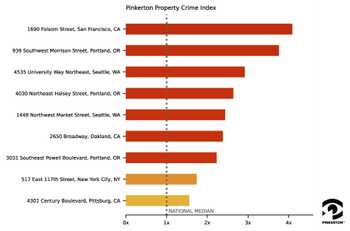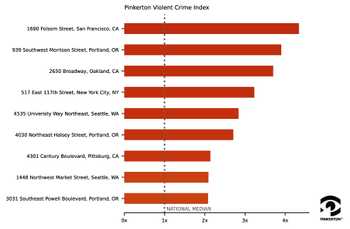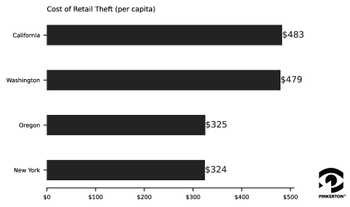Rises in retail theft have become a topic of concern for firms, shareholders, and risk professionals in recent years. And the rising rate of retail theft is largely connected with organized retail crime (ORC).
Organized retail crime and theft focuses on stolen goods that are typically resold — via online or offline marketplaces — rather than kept for personal use. These sales produce financial gains that ultimately fuel other illicit activities such as guns, drugs, human trafficking, and others. The most targeted products in ORC events are accessories, clothing, and electronics.
Neighborhood crime rates linked to retail theft and other offenses
In October of 2023, Target permanently closed several stores in New York City, Seattle, Portland, and the San Francisco Bay area after a spate of high-profile mass shoplifting incidents contributed to diminishing business performance and created unsafe risk environments for staff and shoppers.
Analysis of these locations using the Pinkerton Crime Index demonstrates that the majority of these stores existed in neighborhoods and counties where property crime rates far exceed the national median. (A crime index value of 1x represents a crime rate equal to the national median county.)

The Folsom Street Target store in San Francisco was in a neighborhood in the 100th percentile for national crime — implying it is one of the highest property crime neighborhoods in the country. Eight of the 10 recently closed locations are in the 90th percentile or higher for property crime risk.
In addition to being in relatively risky neighborhoods, many of these locations are surrounded by neighboring locations with even higher crime scores. Crime can expand and migrate from one neighborhood to the next. For example, the 10 neighborhoods closest to Portland’s Morrison Street Target location have a 10% higher crime score, with an average crime index of 4.1x or approximately four times the national median.
Although crime offenses known to the police don’t capture the entirety of retail theft, there appears to be a strong relationship between stores suffering from retail theft and other types of crime. Examining violent crime rates, we observe a similar story for these locations — high neighborhood crime rates and neighborhood rates that tend to be higher than their respective county rates.

Reducing retail crime risk
The Target closures follow many large box-store companies and smaller retailers taking action to reduce risk, including investing in more security staffing and implementing theft-deterrent tools across businesses. More items are found within locked cases in areas where organized retail crime has become an increasingly familiar threat.
These sentiments are reflected in the 2023 Retail Security Survey, an industry survey report produced by the National Retail Federation (NRF) in collaboration with the Loss Prevention Research Center. The survey highlights an increase in the average shrink rate experienced by retailers across the nation, from 1.4% in 2021 to 1.6% in 2022, representing a loss of $112.1 billion.
A report released by the economist John Dunham, “The Impact of Organized Retail Crime and Product Theft in the United States” for the Retail Industry Leaders Association and Buy Safe America published the 2019 retail theft losses of each state. In 2019, reported retail theft losses equated to almost $500 for each person living in California and Washington.

Shoplifting escalates; aggression and violence become more prevalent
The NRF survey also found a widespread trend in raised aggression and instances of violence in connection with shoplifting episodes, with 88% of survey respondents reporting a greater degree of aggression and violence from shoplifters than 1 year prior. Shoplifting events categorized as Organized Retail Crime (ORC) have also become more violent — respondents to a 2021 survey reported that 81% of ORC events had become more violent. In 2022, 67% percent of respondents said that ORC events had become still more violent.
…a spate of high-profile mass shoplifting incidents…created unsafe risk environments for staff and shoppers.
Seventy percent of NRF respondents reported an increase in repeat shoplifting offenders over prior years. This specific population of offenders was associated with a 61% increase in financial losses and a 53% increase in instances involving violence. Similarly, respondents reported a 33% increase in juvenile shoplifting and reported that juvenile shoplifting incidents had become 41% more violent.
To reduce the potential harm to employees, more and more organizations are turning to a strict hands-off approach in terms of their employees confronting shoplifters. The threat of violence against employees or customers has an even stronger impact on retailers than the impact on profitability. Survey respondents cited an impact on their ability to hire and retain quality employees in the face of these heightened workplace risks. Similarly, customer foot traffic has diminished where people are aware of an increased risk of incidents in addition to reduced convenience caused by the limited availability of products.
In response to the rising threat to commerce and physical safety, you can protect your enterprise from organized retail crime with Pinkerton. Connect with us to explore how Pinkerton's comprehensive solutions can equip you with the knowledge, tactics, and security measures to fortify your organization against organized retail crime and theft.
Pinkerton. We never sleep.
Sources:
“2023 Retail Security Survey” National Retail Federation, Loss Prevention Research Council. 2023
Dunham, John. “The Impact of Organized Retail Crime and Product Theft in the United States” Retail Industry Leaders Association, Buy Safe America Coalition. 2019.
“Target Closes Select Stores to Prioritize Team Member and Guest Safety”
https://corporate.target.com/press/statement/2023/09/target-closes-select-stores-to-prioritize-team-member-and-guest-safety. September 2023.
U.S. Census Bureau. U.S. Department of Commerce. Data.census.gov




